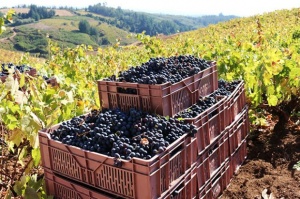Global wine production dips slightly in 2022 despite high temperatures, but in line with average

Global wine production is expected to largely be in line with that of last year, despite the heatwave which affected many regions of the world during 2022.
This would be the fourth consecutive year where the global production level can be considered as slightly below average, according to the world wine  production outlook from the International Organisation of Vine and Wine (OIV). The international wine body, which collated information from 29 wine producing countries representing over 90% of the world’s production has estimated that 2022's production levels to be between 257.5 and 262.3mhl, with a mid-range estimate of 259.9mhl. This is slightly below the 20-year average and is down by 1% compared to the previous year, due to higher than expected harvest volumes in Europe.
production outlook from the International Organisation of Vine and Wine (OIV). The international wine body, which collated information from 29 wine producing countries representing over 90% of the world’s production has estimated that 2022's production levels to be between 257.5 and 262.3mhl, with a mid-range estimate of 259.9mhl. This is slightly below the 20-year average and is down by 1% compared to the previous year, due to higher than expected harvest volumes in Europe.
This year ‘s harvest has been characterised by extreme heat and record-breaking drought that sped up ripening in vineyards across most wine producing regions of the globe, with almost two thirds of European vineyards being in a state of drought or on alert due to heatwave and extremely high rainfall according to the Global Drought Observatory.
With the worst drought in the last 500 years, Europe was not the only region to be affected: from East Africa to California, extreme temperatures have been recorded this year. In the EU, Average production volume is expected, with positive performances recorded in Italy, France, and Germany, which balanced out the low harvests expected in Spain and Greece, which were particularly affected by the summer’s heatwave.
France saw the biggest increase on 2021’s low yielding harvest, up by 17% to reach an estimated 44.2mhl while Slovenia also saw a large increase in volumes, albeit from a low base, up from 0.6mhl in 2021 to 0.7mhl last year, a 15% increase. Neighbouring Croatia also saw a healthy increase, up from 0.5mhl to 0.6mhl.
Conversely Greece saw the biggest year-on-year drop, down from 2.4mhl in 2021 to an estimated 0.7mhl, a 29% decline. This was followed by Luxembourg, down by 13% and the Czech Republic down by 8%.
Initial forecasts for the US harvest indicate that volumes will be slightly down on 2021, with last year’s yield estimated to be around 23.1mhl, a 4% decline on last year, and 6% less than the five-year average. This decline can be partly attributed to early frost damages, drought-like conditions during the summer and consequent lack of water supply in certain wine regions.
In Eastern Europe, wine production in Georgia is estimated to be largely in line with the already high levels of 202, with a record high level of 2.1mhl. This is due to favourable weather conditions leading to high grape yields, as well as a government subsidy programme that has helped push production to record levels.
After the record-high figures of last year, Southern Hemisphere vineyards produced average volumes, with the only exception being New Zealand that, thanks to favourable climatic conditions, recorded its highest ever levels of production.
After a significant decline in production in 2020 caused by unfavourable weather conditions and a record high 2021 harvest, in 2022 the estimate for the Southern Hemisphere is about 55mhl, a 7% reduction compared to the previous year, but fully in line with the last five years’ average. The area’s wine production is expected to account for over a fifth, 21% of the world’s total.
All the top South American wine producing countries have seen a fall in production with Chile, the area’s largest producer seeing yields peaking at 12.4mhl, benefiting from dry conditions and just 7% below last year’s exceptionally high production (which itself was 7% above its five-year average).
However, last year saw Argentina’s production levels decreasing by around 9% due to extremely variable weather conditions, including frost and heavy rain. Brazil, meanwhile, has an estimated yield of 3.2mhl, and even though this represents a decrease of 10% with respect to 2021, the expected volume of this year, despite dry spring and drought summer conditions, is higher than the average observed in the last five years.
In South Africa, wine production for 2022 is estimated at 10.4 mhl, a 4% drop compared to 2021. However, this is in line with its five-year average. Australia posted the largest drop compared to 2021 in the whole of the Southern Hemisphere. With 12.1 mhl, Australia recorded yields plunging by 18% compared to 2021, due to cold spring temperatures and heavy rainfalls in summer combined with seasonal adjustments made by winemakers after the record-high vintage of 2021.
New Zealand is the exception in the Southern Hemisphere, and while it was the only major Southern Hemisphere country in 2021 to have a below-average wine grape harvest, last year saw it hit a record high production level, up by 44% to reach 3.8mhl. A combination of excellent climatic conditions and high international demand has contributed to this historically high harvest volume.
The OIV has cautioned that the figures for 2022 are preliminary as there are still large countries including China and Russia for which data is not yet available. “Additionally, the high volatility in production volumes seen over the past few years at regional levels makes the forecasting exercise even more difficult,” commented the OIV in a statement.
